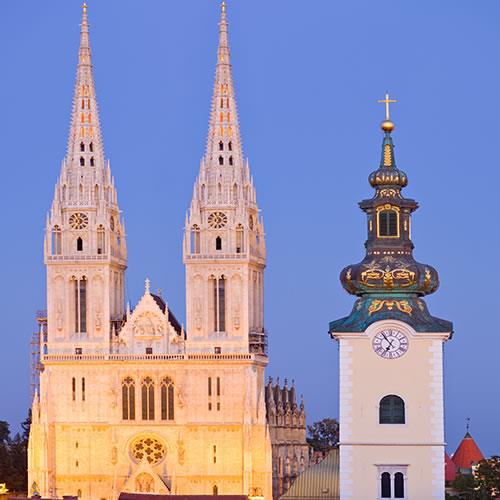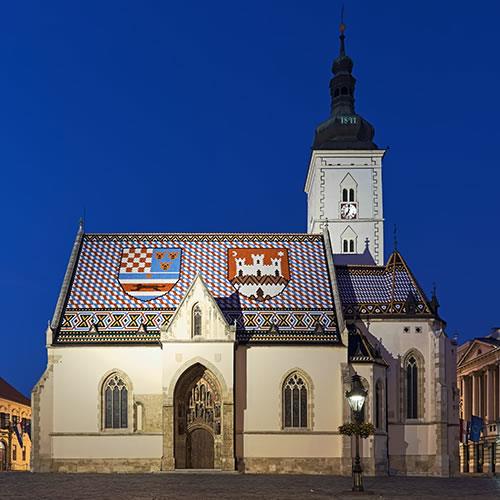ZAGREB - NEIGHBORHOODS


Upper Town (Gornji grad)
The Upper Town (Gornji grad) is referred to by many names, such as Gradec and Gric (much of the Upper Town was built on Gric Hill). Today, the official boundaries set forth by the City of Zagreb consider `Gornji grad` encompassing of the Gradec/Gric area and also the Kaptol area, even though traditionally those two have been separate. For those looking for accommodations specifically in what we label the Upper Town, Ban Josip Jelacic Square and Ilica in the north and Zagreb Main train station in the south are rough boundaries, as are Franjo Tudjman Park in the west and Subiceva ulica in the east.
The Gradec area of the Upper Town was built beginning in the thirteenth century, two full centuries after Kaptol, and is considered part of Zagreb`s medieval core. Sites in the Upper Town include the Mimara Museum, Lenuci`s Horseshoe (consisting of seven green spaces, such as the Zagreb Botanical Garden, King Tomislav Square, and Nikola Subic Zrinski Square, the latter referred to by locals as Zrinjevac), the Mestrovic Pavilion, the Art Pavilion, the Strossmayer Gallery of Old Masters, the Croatian National Theatre in Zagreb, the Croatian State Archives, and at least a half-dozen other museums. Zagreb is known as the `City of Museums` and the majority of these institutions are based in this area. On the north side of the Upper Town, Ban Josip Jelacic Square is the largest city square in Zagreb and it hosts the yearly Christmas market.
There are tram stops outside the Mimara Museum, at Nikola Subic Zrinski Square, outside the Zagreb Trauma Hospital, along the road that leads to the Zagreb Main train station, and along Ban Josip Jelacic Square. The Zagreb Funicular directly links portions of the Upper Town with Kaptol, while Stone Gate (Kamenita vrata, northwest of Ban Josip Jelacic Square by 0.2 miles) was considered the link between the two during the time when much of Zagreb was encircled by city walls.


Lower Town (Donji grad)
The Lower Town (Donji grad) of Zagreb is called centar by locals, because it is considered the modern-day center of the city. Indeed, it is the last part of the city to have been built. It stretches from Zagreb Main train station (Glavni kolodvor) all the way down to the banks of the Sava River, with Savska cesta and Avenija Marina Drzica providing the western and eastern boundaries. For those booking accommodations with us, you will find that our options consist of properties north of Zagrebacka avenija and Slavonska avenija, close to the banks of the Sava, but not directly on it.
Built in the second half of the nineteenth and the first half of the twentieth centuries, many of the more recently-built landmarks in Zagreb, such as the Croatian National Theatre, the Art Pavilion, and the Mimara Museum, are located close by. The Lower Town is where Zagreb Main train station is located, as well as Zagreb bus station, so if you arrive in town by either of these modes of transportation, you will be arriving in town in the Lower Town. You will be stepping onto King Tomislav Square as you leave the train station.
Over 32,000 people live in this neighborhood, which is now moving toward more of a commercial feel, compared to the residential and industrial vibes the area gave off during the time of the former Yugoslavia (especially as you moved closer to the Sava). It has always hosted a large student population due to the close proximity of many university buildings in the area. Tram lines run parallel south of the train station, along Ulica grada Vukovara. The park just south of Ulica grada Vukovara is the area`s centerpiece park, called Sveucilisna livada (University Meadow in Croatian). To the west, you will find many buildings associated with the University of Zagreb, such as the National and University Library.


Kaptol
The Kaptol area is located on Kaptol Hill in the Upper Town area, and is perhaps best-known for being the oldest portion of the city of Zagreb. It is the site of Zagreb Cathedral and the seat of the Roman Catholic Church in Croatia. To the west, you will find St. Mark`s Square, home to the iconic St. Mark`s Church, which was the parish church for what was considered at that time to be `Gradec`, which grew separately from Kaptol centuries later.
King Ladislaus founded the Diocese of Zagreb in Kaptol in 1094, and by 1217, Zagreb Cathedral was completed. The building we see today was not the original, as the original was burned down at the hands of the Mongols in 1242. (The cathedral today is a mix of the replacement building from the 13th century and repairs necessary after the devastating earthquake that hit the city in 1880.) City walls existed to protect the residents of Kaptol from invaders; the wooden fences were replaced with brick walls by the 15th century. The defensive walls that still exist in Kaptol today were portions that dated from the 16th century.
Many sights, such as Zagreb Cathedral, are located on or close to the main street, Kaptol ulica. There are also a cluster of sights around St. Mark`s Square, such as Parliament Palace, where the Croatian Parliament (Hrvatski sabor) meet each year, St. Catherine`s Church, the Klovicevi Dvori Gallery, and Lotrscak Tower.